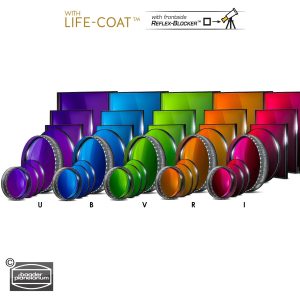Baader Planetarium has introduced a new UBVRI Bessel Photometric Filter Set.
As a background, the UBVRI system was developed in the 1950s for the 0.9m McDonald Observatory telescope and initially consisted of a Johnson UBV filter set, later extended by Cousins to include the R and I filters for the red region of the spectrum. The filters of the extended UBVRI system according to Johnson and Cousins include:
U – Ultraviolet, with a transmission window between about 320 and 400 nm
B – Blue, with a transmission window between about 400 and 500 nm
V – Visible, with a transmission window between about 500 and 700 nm
R – Red, with a transmission window between about 550 and 800 nm
I – Infrared, with a transmission window between about 700 nm and 900 nm.
According to the state of the art at that time, the filters had different thicknesses and transmittance values as well as no sharply defined edges (if any). Their spectrum therefore corresponds to a curve instead of a plateau.
In 1990, M. S. Bessel looked into the subject in order to find a filter combination for the new CCD cameras that were becoming increasingly widespread at the time. These Bessel-UBVRI filters are still standard today and are also the most widely used in amateur circles such as the AAVSO. The V-filter in particular has proved to be an inexpensive introduction to photometry: It corresponds approximately to the visual brightness; since only one measured value is used, this is optimal for getting to know the techniques.
 The new Baader UBVRI Bessel Photometric Filter Set was created to offer a modern filter set that is fully compatible with the characteristics of the original Bessel filters and at the same time meets modern demands for contemporary filters.
The new Baader UBVRI Bessel Photometric Filter Set was created to offer a modern filter set that is fully compatible with the characteristics of the original Bessel filters and at the same time meets modern demands for contemporary filters.
These photometric filters now have the same thicknesses as all other Baader filters: 2 mm filter thickness for all filters up to size 2″ mounted (1.25″, 31 mm, 36 mm, 2″) and 3 mm filter thickness for all sizes above (50.4 mm, 50 x 50 mm, 65 x 65 mm).
This means that they fit into any commercially available filter wheel, for which the original filters were often simply too thick and could not be fixed securely. They are also parfocal with all other Baader filters of the same size and now also available in sizes up to 100x100mm – large enough even for modern, professional sensors, or optimal for easy handling in the common filter mounts for amateur telescopes.
The coating of all photometric filters is manufactured in the same technology as the CMOS-optimized narrowband and LRGB filters. The lifetime Baader Life-Coat guarantee also applies as well.
The new generation of Baader UBVRI Bessel Photometric Filter Set feature:
– Reflex-Blocker coatings, for largest ever freedom from halos, even under most adverse conditions concerning aux-optics.
– Identical filter thickness to existing standards, with utmost care for parfocality.
– Blackened edges all around, with filter-lead-side-indicator in the form of a telescope-sided black outer rim, to additionally eliminate any reflection due to light falling onto the edge of a filter.
– Each filter coated individually, with sealed coating edge (not cut out of a larger plate with coatings left exposed).
– Life-Coat evermore hard coatings to enable a non-aging coating for life – even in a most adverse environment.
– Filter mount choice: 1.25″ round mounted in LPFC 6mm cell.
You can learn more about the new Baader UBVRI Bessel Photometric Filter Set here.
 And to make it easier for you to get the most extensive news, articles and reviews that are only available in the magazine pages of Astronomy Technology Today, we are offering a 1 year magazine subscription for only $6! Or, for an even better deal, we are offering 2 years for only $9. Click here to get these deals which only will be available for a very limited time. You can also check out a free sample issue here.
And to make it easier for you to get the most extensive news, articles and reviews that are only available in the magazine pages of Astronomy Technology Today, we are offering a 1 year magazine subscription for only $6! Or, for an even better deal, we are offering 2 years for only $9. Click here to get these deals which only will be available for a very limited time. You can also check out a free sample issue here.

